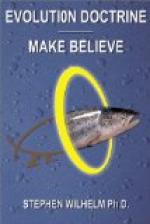In order to become acquainted with the way the structures of animals provide evidences of evolution, it is by no means necessary to review the entire range of their forms, because research has discovered that the principles of relationship are universal among animals, and that any group of examples will demonstrate what is taught by comparative anatomy as a whole. The commonest creatures may serve us best in order that we may come to view evolution as a process that involves each and every living thing that we know, and not as something which belongs only to the remote and unknown past.
Let us begin with the common cat and the group of carnivora or flesh-eating animals to which it belongs. As we pass along the streets of the city, we will see many cats which differ in some details, though they resemble one another closely. While they vary somewhat in form, the range in this quality is not so noticeable as in the matter of color; some of them will be gray, some maltese, while others will be yellowish or black, and they will differ in the striped or spotted character of their coloration. We readily classify them all as “cats” in spite of their differences, because they are alike in so many ways that we have learned to associate as the distinguishing characteristics of these animals, and to label—“cat.” The animals which we might see in a walk of several blocks may reasonably be regarded as offspring of the same pair of ancestors of a few years back, even though they are dissimilar. We all know that the kittens of one and the same litter vary: no two of them are ever exactly alike in color or disposition or voice or size, nor is any one identical with either of its parents, although it may be necessary to employ exact means of measuring them in order to demonstrate their variation. The fact of difference, then, is surely not inconsistent with even the closest ties of blood, and we do not need to go beyond the scope of daily observation to find that this is true in nature wherever we look.
Should we extend our observations so as to include the cats of Boston and Philadelphia and San Francisco, the animals would probably vary over a wider range, but they would be so similar to New York cats in their make-up that we would have no difficulty in regarding them and all the others of the United States as the descendants of a single pairs of ancestors, perhaps brought over in the “Mayflower.” But why does this view seem justified? Because experience has taught us that the living things which resemble each other most closely are those which are most intimately bound by ties of blood and common heritage. It is “natural” for relatives to resemble one another more than persons not related, and for brothers and sisters to be more alike than cousins. Science does not refer to something outside everyday observation when it states that the possession by two animals of a great body of similar characters beneath their minor differences is an indication of their common ancestry.




